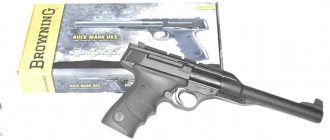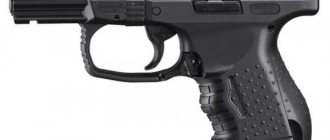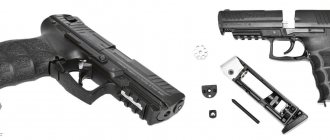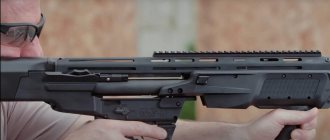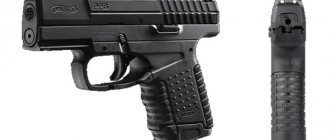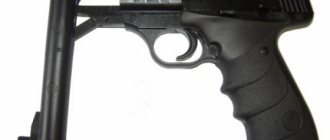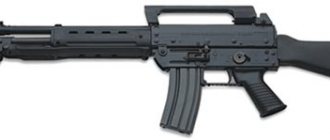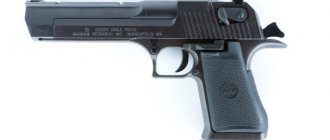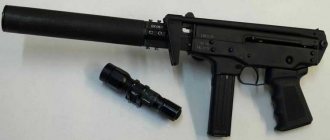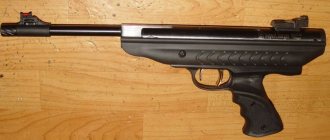Background
Have you been trying to heal your JOINTS for many years?
Head of the Institute for the Treatment of Joints: “You will be amazed at how easy it is to cure your joints by taking the product every day for 147 rubles...
Back in 1884, in the German city of Jena, a boy was born into the family of a noble European gunsmith Louis Schmeisser, who was named Hugo.
His childhood years were spent in stable German prosperity, and his father’s example encouraged the young man to take up arms making at a factory in Suhl.
His father was involved in design issues, and Hugo gained experience and education.
The consequences of the shot in Sarajevo rolled down like a pebble. The boots of the Reichscheer soldiers rumbled across Europe. But very soon, the First World War became bogged down in endless lines of trenches, swamps and endless fields of barbed wire.
This is where the stellar moment of the design genius Hugo struck! Using his father's work, he developed an automatic carbine with an aiming range of 200 meters! (at that time - a revolution!).
Having received the newborn MP-18 (about 35 thousand guns), German units broke through the defenses of the Entente troops and gained operational space in France.
A little later, Operation Mekhael also got stuck in the mud and revolutions, but the Hugo machine gun proved itself to be the best.
Then there was the Versailles Peace Treaty, which was shameful for Germany, and working on automatic weapons projects became very difficult. But the tireless Hugo, with the help of his brother Hansi, establishes a private armory and begins to design his own automatic weapons.
And the MP-28 was born, a submachine gun that entered service with the German police in 1928 (later used in the 30s in Spain during the civil war).
The box magazine was attached to the MP-28 from the side; the machine gun had a wooden stock.
While developing new models of weapons at his factory, Hugo did not imagine exactly how he would remain in history...
Technical characteristics of Schmeiser PGSh
The main technical characteristics of the PGSh are as follows:
- For shooting, 9 mm RA cartridges are used;
- The pistol barrel is 84 millimeters long;
- The length of the gun itself is 156 millimeters;
- The height of the gun is 117 millimeters;
- The width of the pistol is 25 millimeters;
- The weight of the unloaded pistol is 485 grams;
- Accurate shooting can be carried out at a distance of 3-5 meters from the target;
- The magazine holds 8 rounds.
The trigger mechanism here, as in many other cases, is made according to a double-action design with an open trigger and a round hole in the spoke. A sheplato has been introduced into the trigger, which increases the reliability of the entire mechanism and also allows you to set the trigger to cocking. The trigger pull is 3 kilograms when the hammer is cocked and 6 kilograms when firing in self-cocking mode. In general, the PGSh's USM works smoothly, there are no failures.
The sighting mechanism is also standard: a fixed front and rear sight of medium size, which allow the shooter to aim as comfortably as possible. Effective and accurate shooting can be carried out at a distance of 3-5 meters from the target; as distance increases, accuracy and accuracy begin to decrease significantly.
Possible tuning
An upgrade can have a positive impact not only on the appearance of an electro-pneumatic weapon, but also on its functionality. In order to increase the rate of fire of the Schmeisser MP-40 assault rifle, it is advisable to resort to installing a more powerful spring. You can also increase the overall battery voltage to resolve this issue. These characteristics have a direct impact on the formation of the gear ratio. Replacing the piston can increase the muzzle velocity of the bullet. The main function of this element is to compress the air inside the cylinder.
Video review of the Schmeisser MP-40 air pistol:
The development of the MP-40 submachine gun with two magazines began after reflecting on the experience of combat operations on the Eastern Front in the initial period of the war. Until June 1941, German submachine guns were superior to the enemy's automatic weapons in all respects; moreover, often the enemy did not have weapons of this class at all.
The situation took a different turn after the collision of the German military machine with the Red Army. As it turned out, the Red Army was armed with a large number of submachine guns, which were superior to the German ones in terms of characteristics, magazine capacity and, moreover, were simpler and cheaper to produce.
Most of all, German gunsmiths were struck by the simple and reliable Soviet submachine gun PPSh-41, equipped with a disk-type magazine for 71 rounds. German soldiers greatly valued these submachine guns, considering them the most coveted trophy. To a large extent, the popularity of the PPSh among the Germans was facilitated by the capacious magazine of the Soviet submachine gun. In October 1942, the commander of the SS Viking division even came up with a proposal to establish mass production of PPSh in the Reich, because it was significantly superior to German submachine guns. The division commander noted in his report the advantages of the Soviet assault rifle over all known German models, especially pointing out the large capacity of the disk magazine.
“Russian submachine guns are widely used in our division; they have proven themselves to be very reliable even in the most unfavorable conditions.” So in 1942, to increase firepower, the Steyr plant in Austria, which produced the MP-40 for the Germans, developed the MP-40/I variant, which had a dual magazine receiver that could accommodate two magazines. The variant was intended to arm special forces units. The receiver had the ability to move transversely in the weapon, so that after using up the cartridges in one standard magazine, the shooter in one movement moved the second magazine to the working position and could continue firing.
The weapon's ammo capacity doubled (from 32 to 64 rounds), but the movable magazine receptacle caused frequent delays due to contamination, and production of the MP-40/I was very low. The MP-40/I was created between the end of 1942 and mid-1943. It first appeared in the “Geratlist” (list of weapons of the German army) in June 1943. All known examples were assembled by Steyr and Erma in the second half 1942 and the first half of 1943
The weapon supply system from two magazines was allegedly developed by specialists from the Erma company. This theory is confirmed by the appearance of the EMP-44 submachine gun, an experimental weapon also equipped with two magazines. Development of this submachine gun began in 1942 (the surviving sample has serial number 000015, assembled in February 1943). For unknown reasons, all work on the EMP-44 submachine gun was stopped after the production of several prototypes, after which, apparently, the company transferred the device for attaching two magazines to the MP-40. Most likely, this is how the MP-40/I appeared.
Shooting range report: MP 40 nicknamed "Schmeisser"
In a new section we will talk about testing captured, Lend-Lease and experimental Soviet small arms units. The first publication is devoted to the MP 40 submachine gun in comparison with the PPSh-41
During the war years, hundreds of small arms samples passed through the Red Army Small Arms Research Site - NIPSVO KA. Captured, Lend-Lease, experienced Soviet - all these units passed through NIPSVO testers. It was there, in particular, that the famous teaching staff was created by test site employee Alexey Sudaev. And there, after the war, the final stages of the “automatic” competition took place, as a result of which an assault rifle designed by Mikhail Timofeevich Kalashnikov was recommended for use in the army.
Of course, during the war years, especially close attention was paid to the enemy’s weapons. Before the war, German submachine guns were already studied at the training ground; in particular, the Schmeisser 18/28 and the Bergman MP-34 were carefully analyzed. After June 22, 1941, numerous reports began to come from the front about “German machine gunners,” whose main weapon was believed to be the Maschinenpistole 40, erroneously called a “Schmeisser” in many sources, although it was developed by the designers of the Erfurter Maschinenfabrik (ERMA) without the participation of Hugo Schmeisser. In fact, in the German army, the submachine gun was considered more of a secondary weapon, which was issued to the crews of military equipment, lower-ranking command staff, paratroopers, and so on. Nevertheless, the image of a German machine gunner with rolled-up sleeves pouring water from his stomach from a Schmeisser successfully survived the war and, thanks to Soviet cinema, became widespread and recognizable to all residents of the former USSR.
However, when a captured submachine gun was delivered to the shooting range for study, its “cinematic quality” hardly bothered the testers.
The combat characteristics of the German submachine gun turned out to be quite high. For example, the results of comparison shooting with PPSh for accuracy looked like this:
Although the “German” weighed less than a PPSh with a disc magazine, due to the slower rate of fire it was easier for the shooter to control it when shooting.
At the same time, the German machine gun, as the testers noted in their report, was a “wartime” design - with a large percentage of the use of stamping, spot welding, and cheap materials.
The report noted the following design features of the MP-40, which distinguished this submachine gun from previously studied images: in the “non-Schmeisser” the shutter speed in the rear position was measured to be zero - that is, during recoil, all the energy of the massive part was absorbed by the return spring and buffer device. This had a very positive effect on both the shooting accuracy and the survivability of the weapon, whose receiver did not experience constant impacts. Typically, designers still tried to design circuits with excess energy at the gate - as an example, the report mentioned the Suomi PP as “a Finnish weapon designed to operate in low temperature conditions.”
But the creators of the MP-40 found other ways to ensure reliable operation of their submachine gun. Their approach was based on two parameters - the area of the rubbing surfaces of the bolt and receiver and the amount of movement of the bolt behind the cartridge. For MP-40 these parameters were 16.1 cm and 115 mm. For comparison, Suomi, according to the test site, had the same indicators of 60 cm and 42 mm, and our PPSh had 59.4 cm and 39 mm. The first figure meant that the MP-40 had minimal energy losses due to friction, and the test site specialists were very interested in how the Germans were able to achieve such an effect.
“The small amount of friction surface between the bolt and the receiver in the MP-40 software is achieved by introducing two bolt fitting bands, and the rest of the bolt and the receiver are not in contact. In addition, in the MP-40 PP, the receiver has 4 stamped longitudinal guides along which the bolt slides with its stripes...
The above circumstance also has the significance that dirt, dust, and copious lubricant that gets inside the automation can be located after the first two or three shots, between the gaps of the bolt and the receiver and subsequently not affect the operation of the automation.”
The final conclusion of the testers was as follows:
“The positive properties of the MP-40 automation deserve the most serious attention. In addition, the MP-40 submachine gun has many successful design solutions in the design of various mechanisms and design.
From a technological point of view, it is of serious interest to manufacture the main parts of the MP-40 by stamping from sheet steel.”
It is worth noting that even before the appearance of the MP-40 at the test site, requests began to come from the front “to make us the same one.” Tankers were especially active in this - the MP-40 with its folding stock was clearly much more suitable for placement in tight armored spaces than the PPSh.
Therefore, it should not be surprising that in the competition for a new submachine gun held in 1942, many samples had “some resemblance” to the MP-40. And the chairman of the testing commission, engineer major Okhotnikov, noted that he considers the German system: “more fully meeting modern requirements for weapons, because it is designed as a universal weapon.”
However, the MP-40 also had its own “Achilles’ heel,” which its “main users” were well aware of.
For example, the German instructions on arming groups of military reconnaissance said the following: “Machine gunners, in addition to the machine gun, must be armed with pistols (carry in their uniform pockets in case of self-defense if the machine gun fails).” Another instruction specified the problem: “To preserve the clip springs (as in the document) in a non-combat situation, keep them without cartridges, clean and lubricated. Before filling the clips with cartridges, just like machine guns, thoroughly wipe them and lightly lubricate them with oil. 24 cartridges are inserted into the clip; to avoid clogging, place the clip in the pocket with the hole facing down.”
Let us recall that the standard capacity of MP-40 magazines was 32 rounds. Elsewhere it was also recommended to insert two springs into the magazine instead of the standard one.
However, the closer the front line came to the borders of the Reich and the more German factories turned to dust under Allied bombs, the further the products of those remaining could deserve the phrase “famous German quality.” Attempts to further simplify and reduce the cost of the design naturally led to a decrease in combat qualities and reliability. The MP-40s at the end of the war were far from being “the same” - as, indeed, the entire Third Reich.
So was it Schmeisser?
The question still remains open as to what part Hugo Schmeisser took in the creation of the MP 40. Still, the glory of the creator of the legendary machine gun belongs to Heinrich Vollmer, although the fates of these people are very closely intertwined. Back during the First World War, Volmer invented a portable hose magazine for the MP 18 assault rifle, which was born by the hands of Schmeisser. In turn, the magazines used in Vollmer’s machines are a patented solution by Schmeisser. In 1944, the MP41 assault rifle was created, which was a definite departure from the traditional MP 40. It was the same assault rifle, only enclosed in a wooden case. The MP41 also received a single-fire mode and an increased rate of fire. This machine was not widely used. One interesting point is that the idea of creating this machine gun belonged to the well-known Hugo Schmeisser, who, even while working after the war in the USSR, left a whole lot of weapons secrets...
The performance characteristics of an airsoft weapon, which include the quality of the materials used, the rate of fire and the overall weight level, determine the quality of the game. Modern manufacturers of airsoft machines have to exist in conditions of fairly fierce competition. The main goal pursued by companies producing this type of weapon is to create a high quality product.
The pneumatic automatic machine Schmeisser MP-40 is produced by the German company SRC. This type of weapon is characterized by high build quality and extreme reliability. The product can be used in various conditions for a long period of time. Schmeiser MP-40 is a kind of modification of the MP-38 model.
The main design difference between the two weapon models is that the MP-40 has a stamped receiver, and the MP-38 has a milled one
You should also pay attention to the change in the magazine neck. Stamped ribs appeared on it, the presence of which has a positive effect on the overall strength potential of the product
Advantages and disadvantages
The body of the machine is made of high-strength steel, so the product is resistant to various mechanical damage. The magazine can hold up to fifty shells at a time, so there is no need to frequently reload the weapon. The high-quality SRC GEN 3 gearbox and the new MOSFET controller deserve special attention. The latter is built into the trigger mechanism.
The most problematic aspects of this include the lack of a safety lock and the low effective firing distance. The initial speed of the bullet also leaves much to be desired - the projectile flies out of the barrel at a speed of 90 km/h.
Another drawback is the lack of a handguard, which leads to overheating of the barrel at high firing rates. This moment may cause some discomfort. The disadvantages of this model also include the inconvenient location of the folding stock.
Advantages:
- spacious magazine (50 shells);
- durable steel structure;
- convenient German markings;
- the presence of a special controller in the trigger mechanism;
- high build quality.
Disadvantages of the Schmeisser MP-40 pneumatic machine:
- lack of fuse;
- low initial bullet speed (90 km/h);
- lack of fore-end;
- possible difficulties with manual loading (the model is additionally equipped with a special device).
Photo of the pneumatic machine Schmeisser MP-40
Purpose
The main purpose of this type of weapon is to play airsoft. In addition, the Schmeiser MP-40 can be used for recreational shooting and hitting targets at short distances. The Schmeisser MP-40 assault rifle can also be used for plinking.
Creation of Schmeiser
Schmeiser MP40 - the best weapon of the Third Reich? Being intended primarily for airborne troops and tank forces, the Schmeisser assault rifle differed from its competitors in the absence of a wooden stock and the presence of the first, for that period of time, folding butt. This design provided ergonomics that were relevant for auxiliary and mobile troops, and therefore was highly popular among them. The MP40 shutter lever was located on the left side, which did not allow a right-handed shooter to justifiably carry the machine gun on his chest, hanging it by a belt around his neck. The Schmeiser MP40 automatic system was based on the recoil of a free shutter, the braking of which was carried out thanks to a telescopic spring located behind it. It was through the introduction of this technology that the rate of fire of the German machine gun was reduced to 400 rounds per minute, thereby significantly increasing its accuracy. Using such a weapon, an experienced shooter could effectively hit targets at a distance of up to 150 meters, which is a fairly high indicator for a SMG.
The safety lever and fire mode switch are missing. To safely carry a weapon, the bolt lever can be installed in a safety groove that completely blocks its movement. To fire single shots, only a partial pull of the trigger is required. The original model was fed with ammunition using box magazines with a capacity of 32 rounds, the design of the receiver for which was far ahead of its time. The Schmeisser MP40 used 9x19 Parabellum cartridges as ammunition, which, given the low level of personal protection of that time, were incredibly effective at certain distances.
As for sighting devices, in the MP40 they are represented by a fully adjustable sight for 100 and 200 meters, and a ring front sight. Holding the machine gun while aiming is carried out by resting the butt on the right shoulder and guiding the magazine receiver with the left hand. MP40 the most famous predecessors and successors Close-up The first German assault rifle similar to the familiar Schmeisser was the 1938 model with the appropriate name MP38. Unlike its competitors, it already had the famous folding stock, a capacious magazine located in the lower part of the receiver, as well as a locking protrusion that allowed the weapon to rest against the sides of the vehicle, thereby increasing shooting accuracy.
A further development of the model was the MP38 sample, which differs from its predecessor in slightly better ergonomics and a more reliable method of manufacturing parts - milling. Despite the high cost, this approach was much more profitable than stamping due to the lack of an appropriate scientific and technological base for the latter. After the spread of the MP40 model at the front, the Germans were inspired by the success of the Soviet competitor PPSh, which is why the rare MP41 model was born. It was at this stage of production that the famous designer Hugo Schmeiser joined the pistol-machine-gun franchise. Having in its arsenal a real rifle stock, the new German machine gun could not boast of having a pistol grip, while providing high accuracy of fire. At the same time, it was possible to fire single shots in earlier models, and the 41st could not boast of any innovative innovations, which was the reason for its failure in the military market.
System
Automation of both MP 38 and MP 40 works on the principle of recoil of a free bolt with a stationary barrel. The principle of “roll-out shot” developed by Hugo Schmeisser is used, that is, when the firing pin comes into contact with the cartridge primer at the moment the barrel bore is locked. The barrel bore is locked by a massive bolt. Due to the large weight of moving parts, a weak return spring and a pneumatic damper, the submachine gun has a relatively low rate of fire, which has a positive effect on the accuracy of the battle. The MP 40 has a striker-fired firing mechanism and is designed for continuous fire only, but due to its low rate of fire, well-trained shooters can also fire single shots. The submachine gun does not have a safety catch. It is replaced by the presence of two grooves for the bolt handle on the left side of the bolt box. One cranked groove in the breech of the casing is for preparing for firing, and the second located near the chamber is for tightly locking the barrel bore in camping equipment. The MP 40 is equipped with a rack-mount sight with two sights: a constant one for a distance of 100 m and a folding one for a distance of up to 200 m. When firing at a distance of more than 200 m, the effectiveness of fire sharply deteriorated. In combat conditions, the lack of a protective casing on the barrel also created inconvenience, so to avoid burns, soldiers often used gloves during shooting. A “hook” was made at the bottom of the barrel for ease of shooting from the sides of armored vehicles, cars or other shelters.
Receiver
The receiver is made from rolled sheets of cheap carbon steel. On top is the base of the sight, which contains a bar with an aiming post, on which there is a slot for a permanent sight at 100 meters and a folding bar with a slot for shooting at a distance of 200 meters. A clip made of sheet material is put on the front part of the bolt box. The lower part of the clip forms the magazine receiver, inside which there is a magazine latch and a reflector (attached with a pin). On the right side above the magazine receiver on the bolt box there is a window for ejecting cartridges.
Butt
The disadvantages are primarily related to the chosen cartridge. The ballistic characteristics of the 9x19 mm Parabellum cartridge could not give a high initial bullet velocity and, accordingly, a good trajectory flatness. However, a low effective firing range is a general drawback of weapons chambered for a pistol cartridge, however, the Soviet SMGs that the MP 40 had to face on the Eastern Front were chambered for a very powerful, by the standards of this class of ammunition, Mauser-Tokarev 7.62×25 cartridge mm, which obviously had better ballistics.
Among the actual design flaws one can identify:
In terms of reliability, the MP 40 was slightly inferior to the Soviet PPSh-41 and PPS, but was more practical. During the fighting on the territory of the USSR, a decrease in reliability at sub-zero temperatures was revealed, which, however, applies to all similar types of weapons. Cleaning the MP 40 in the field was extremely difficult due to the abundance of fairly small parts and the tubular receiver.
It should be noted that almost all the main shortcomings of the MP 40 were corrected in its post-war Spanish version - Star Z-45. The 9 mm Largo (9x23 mm) cartridge, more powerful than that used in the MP 40 9x19 Para, improved the ballistics of the weapon. The barrel was covered with a perforated metal casing with a muzzle brake - a compensator in the form of six cuts in the front and top, which made it possible to reduce the tossing of the weapon when firing and thereby improve the accuracy of the battle. A fire mode selector appeared: when the trigger was pressed lightly, single shots were fired, and when pressed firmly, automatic fire occurred. The sighting devices were improved, and the cocking handle was moved to the right side of the receiver (the handle of the MP 40, located on the left, when carrying the weapon in the “chest” position, stuck into the shooter’s chest, causing him significant discomfort). This weapon, designed in pre-war times, was in service until the 1960s.
The German MP-40 submachine gun, which was called the “Schmeisser” in the USSR, is as legendary a weapon as the PPSh assault rifle or the Mosin rifle. Thanks to Soviet cinema, the typical image of a Hitler soldier became a young man with rolled up sleeves, firing from the hip from an MP-40. Although, it should be noted that the MP-38/40 submachine gun was neither the most common nor even the most popular type of small arms in the German army. But at the same time, the MP-38/40 assault rifle is one of the best types of submachine guns of its time. True, he had nothing to do with the talented German weapons designer Hugo Schmeisser.
History of the creation of weapons
The first submachine guns appeared during the First World War. According to the developers, this rapid-fire small weapon, which used a pistol cartridge, was supposed to significantly increase the firepower of the advancing troops.
Under the terms of the Treaty of Versailles, Germany was allowed to equip police units with submachine guns, and in the 20s and 30s the country was actively working on the creation of new types of such weapons. One of those who developed new submachine guns was the talented German designer Heinrich Vollmer.
He made several successful submachine gun designs from 1925 to 1930. In 1930, the German company ERMA bought all rights to the weapon created by Volmer. And soon the Nazis came to power in Germany, and now new submachine guns were being developed for the needs of the new army.
In the mid-30s, ERMA produced the EMP 36 submachine gun, which, in fact, was the predecessor of the MP-38 and MP-40 assault rifles. This weapon was very similar to previous submachine guns created by Volmer, but it had many modifications. The wooden stock disappeared, it was replaced by a metal frame, the magazine was located at the bottom of the weapon, replacing the wooden handle. The wooden stock was replaced by a folding metal stop. In general, the weapon acquired the appearance familiar to us from the films. True, the magazine was directed slightly forward and to the left of the axis of the machine gun.
But the main thing was something else: the developers, anticipating the future scale of production, began to use new production technologies, namely, the cold stamping method. This way they were able to make the EMP 36 much cheaper and simplified its production. However, the new submachine gun had a large number of shortcomings; the manufacturer had to modify it. As a result, the MP-38 assault rifle appeared.
At first it was produced in small quantities, less than nine thousand units of this weapon were delivered to the troops, but the outbreak of large-scale hostilities completely changed this situation.
For its time, the MP-38 assault rifle had a truly revolutionary design. It did not have a conventional wooden stock, which made it especially convenient for tankers, paratroopers, and police. No wood was used in the manufacture of the MP-38, only metal and plastic (it was first used in the design of submachine guns). The front handle of the weapon was replaced by a magazine, the reloading handle was moved to the right side, which made it possible to constantly keep your finger on the trigger. Longitudinal stiffening ribs were made on the weapon casing, and aluminum was used in the design. The relatively low rate of fire of the MP-38 increased the accuracy and controllability of the weapon.
At the end of 1939, the MP-38 L was released, which can be called a modification of the submachine gun. It can be considered an experimental model; aluminum was actively used in its production, but the design itself was simplified. This submachine gun was more suitable for mass production, although due to the use of aluminum it became more expensive. Some technical solutions were later used in the development and production of the MP-40.
Work on the creation of the MP-40 began already in 1939. Its first batch was released by the end of the year. Gradually, all enterprises that produced the MP-38 switched to the production of a new modification of the weapon. It was the MP-40 that became the main modification of this submachine gun; in total, more than a million copies of this weapon were produced.
The MP-40 submachine gun is easier to manufacture; its design has more stamped parts (handle frame, for example), which made it cheaper compared to the MP-38. It has less weight, the appearance of its body is different, there are differences in the magazine mounting mechanism and in the design of the fuse.
During the war, the MP-40 underwent several changes aimed at further simplifying its design and reducing the labor intensity of production. Which is not surprising given wartime conditions. Experts name five modifications of the MP-40. However, this classification is somewhat arbitrary, because changes were made gradually in different periods, at different factories. At the front, parts of different modifications were swapped, using old serviceable parts to repair new machines.
In 1941, Hugo Schmeisser proposed his own modification of this submachine gun. He connected the main mechanisms of the MP-40 and the stock with the trigger mechanism of the MP 28/II. This hybrid could conduct both single and automatic fire, and had a higher accuracy of fire due to the convenience of the wooden butt. However, it was not accepted for service; it was produced in small quantities, and was also supplied to the armed forces of Romania and Croatia.
ERMA designers also developed the MP 40/I submachine gun, which could be equipped with two standard magazines at the same time. But it turned out to be too expensive and difficult to produce, so its production was quickly curtailed.
Description of design
The MP-38 and MP-40 automation operates due to the recoil of the free shutter. The barrel is locked with the help of a massive bolt. The shot is fired when the barrel is locked. The massiveness of the bolt, the weakness of the return spring and the damper make the rate of fire low.
The weapon does not have a safety lock; instead, there are two grooves in the bolt box into which the charging handle fits, preventing the possibility of an accidental shot. Sights consist of a rack sight and front sight.
The bolt box is made of cheap steel, sighting devices are fixed on it, in the front part there is a magazine neck with a mechanism for fastening it, and on the right above the neck there is a window for extracting cartridges.
The bolt sends the cartridge into the chamber, pierces the primer, and also extracts the cartridge case. The firing pin is located in the bolt; its base rests on the return spring, which is located in a casing made of a telescopic tube. The tube increases the reliability of the weapon by protecting the spring from contamination.
The buttstock consists of an axis with a latch, stops and a butt plate. It folds down and forward under the trigger box.
The machine is fed from a box magazine with a capacity of 32 rounds. On the first modifications of the weapon, the magazines were smooth, then they were given stiffening ribs. When shooting, you had to hold the weapon by the neck of the magazine; holding the magazine would lead to the cartridge being skewed.
A characteristic hook was made on the lower part of the barrel, designed for ease of shooting from embrasures, from the sides of armored vehicles or other shelters.
Use of MP-38 and MP-40
At the time it entered service, the MP-38 was undoubtedly the best submachine gun in the world. Lightweight, compact, reliable, made of high-quality materials - no one else in the world had anything like it. But this is precisely what prevented the MP-38 from becoming the main machine gun of the German army. A large number of milled parts increased the cost of the weapon, making it not very suitable for the role of a mass-produced weapon.
Therefore, the MP-40 was developed. Simplification of the design did not greatly affect the characteristics of this submachine gun. It was adopted as an individual small arms weapon for tankers, drivers, paratroopers and junior officers.
The undoubted advantages of this weapon include low production costs, compactness, light weight, good accuracy of fire, and good stopping effect of the bullet. However, there were also disadvantages.
The weak point of the MP-40 was the magazine; it required careful treatment (it did not tolerate dirt well), and it often jammed. There were also problems with the metal butt of the weapon. The butt lock quickly became loose.
The 9x19 mm Parabellum cartridge itself, which was used in the MP-38/40, had low power and low muzzle velocity.
Disadvantages include the lack of a barrel casing, as well as the great difficulty of cleaning the weapon in the field.
Despite this, the MP-40 was actively used by German troops throughout the Second World War. Soviet soldiers did not disdain these weapons, and intelligence officers especially loved them (because of their compactness), but the PPSh and PPS were superior to the German machine gun in reliability and ease of production.
Specifications
| Model | MP 38 | MP 40 |
| Cartridge | 9x19mm Parabellum | |
| Caliber, mm | 9 | |
| Weight without cartridges, kg | 4,18 | 3,97 |
| Weight with cartridges, kg | 4,85 | 4,7 |
| Length, mm | 833 | |
| Barrel length, mm | 248 | |
| Number of rifling | 6 right-hand | |
| Rate of fire, rds/min | 400 | 500 |
| Effective range, m | 100 | |
| Sighting range, m | 200 | |
| Initial bullet speed, m/s | 390 | |
| Number of cartridges in the magazine | 32 | |
| Years of production | 1938-1940 | 1940-1944 |
Source - https://militaryarms.ru/
Similar products
Magazine loading accelerator for MP 38/40 (on order)
4 450 p
Add to cart Notify
Covers for MP-40
950p
Add to cart Notify
Leather pouches for MP40 (on order)
6 800 p
Add to cart Notify
Other problems
In addition, holding the PP in battle caused big problems. The fact is that it was strictly not recommended to grab the magazine: its holding mechanism was so flimsy that it quickly became loose. There were often cases when the magazine of MP-38/40, which had been badly beaten by life, could simply fall out right during the battle. So you had to hold it directly by the barrel... which did not have a casing. To prevent the soldier from frying his palms, he was required to wear an asbestos glove.
Oddly enough, neither the heavy bolt nor the powerful return spring protected the machine from its excessive tendency to jam at the slightest contamination. Despite this, the MP-40 assault rifle in the initial periods of the war fully met all the requirements for such weapons. Only with the loss of the strategic initiative by the Nazis did they have to develop the world's first assault rifle, the StG-44.
Story
The consistent German “genius” never dozed off. In addition to Schmeiser, other designers were also involved in the development of automatic weapons.
In the twenties of the last century, the no less ambitious designer Heinrich Volmer, having studied Hugo’s creations, came up with a model of a submachine gun with a disc cartridge feed magazine and a wooden handle. Thus, in 1926, the VMP-1926 model was born.
Continuing development, Volmer introduced new models, changing the design features of the cartridge feeding mechanism, improving the stock and butt. The products were sold to European countries (even to Sweden).
She bought the designer's projects and soon released the EMP (1932) assault rifle under her own brand, which stood for Erma Maschinenpistole.
Meanwhile, it was 1933, and the growing German army had to be equipped with modern weapons.
Through a series of intermediate models (in particular EMP-36), the MP-38 was born. He was born in serious pain - the parameters of the model were changed. All wooden parts were removed. The stock became a metal folding one, and the magazine moved downstairs.
In 1938, it began serial production of submachine guns. But, despite this, by 1939, only about 9,000 Maschinenpistole-38 had arrived in warehouses.
The front handle was replaced by a 32-round box magazine. With these weapons the Third Reich began its blitzkrieg.
Full metal construction with bakelite forend and pistol grip. Only automatic fire, the rate of fire was artificially reduced by a casing of a telescopic design, which housed the return spring.
But nevertheless, these weapons required significant labor costs during production. This came from a significant amount of milling and turning work during its production. For this reason, an attempt was made to improve the weapon, or rather to simplify it technologically.
It's time for the MP-40. An experimental batch was born at the end of 1939. and Haenel (a little later) began to produce exclusively MP-40 due to higher manufacturability, low cost and ease of manufacture.
Capacity at its peak reached up to 10 thousand machines per month. Between 1940 and 1944, German industry produced about 707 thousand MP-40 submachine guns.
The new automatic weapons were mainly used by airborne units and special forces. Then there are officers, armored vehicle crews, artillery crews, and military transport drivers.
By mid-1941 (before the attack on the USSR), the Wehrmacht was armed with approximately 240 thousand MP-38/40 assault rifles. But already in 42-43, more than 450 thousand machine guns were delivered to the German army, which indicates an increase in the production of this type of weapon.
Which was completely justified, given that the submachine gun, despite a number of shortcomings, proved to be a fairly powerful and necessary weapon in the changed battle conditions.
By 1944, the production of the MP-40 was curtailed, the German industry switched to the production of a new creation by Hugo Schmeisser - and the Italian Beretta M38A/42 submachine guns (due to ease of production), which received the German marking MP - 738 (i). In total, about 150 thousand of them were produced.
Especially for infantry units, Schmeiser proposed the MP-41 submachine gun with a wooden stock and butt; this option was more convenient for hand-to-hand combat; in addition, with a fixed butt, shooting accuracy increased.
But the German Armaments Directorate was not interested in this submachine gun. The Henel plant produced about 28 thousand copies ordered by the Romanian army.
In 1943, a modification of the MP40 was developed - MP40/L with two magazines, but it did not go into mass production due to its severity and sensitivity to contamination.
Pneumatic submachine gun Umarex Legends MP-40 German Legacy Edition
Packaged dimensions: 670 x 235 x 90 mm
Shipping weight: 4,335 g
Characteristics of Umarex Legends MP-40:
| Manufacturer: | Umarex (Germany) |
| Guarantee: | 12 months |
| Caliber: | 4.5 mm (.177) |
| Combat prototype: | submachine gun MP.40 (Germany) |
| Based on the operating principle (?): | gas-cylinder pneumatics |
| Energy Source: | 12 gram CO2 gas cartridges x2 |
| Muzzle energy (?): | up to 3 J |
| Ammunition: | BB balls 4.5 mm |
| Magazine capacity: | 50 |
| Gate: | mobile |
| Blowback (?): | Yes |
| Shot speed: | 140 m/s |
| Material: | body - metal, plastic |
| Color: | looks used (used look) |
| Trigger mechanism (?): | single action |
| Shooting mode (?): | semi-automatic / automatic |
| Fuse: | non-automatic, switch |
| Sights: | adjustable aiming bar, fixed front sight |
| Weaver/Picatinny rail: | No |
| Barrel type (?): | smooth |
| Dimensions: | 615(825)x270x51 mm |
| Weight: | 3540 g (4335 g - packaged) |
| Peculiarities: | folding stock |
| Equipment (?): | submachine gun, magazine, hex key, instructions, box |
| Certificate: | |
| Instructions: |
Description of the Umarex Legends MP-40 air pistol:
pneumatic submachine gun is a gas-cylinder version of the German MP-40 submachine gun, a legend from the Second World War. This weapon is often called Schmeisser, named after the German gunsmith H. Schmeisser, although the creator of the MP-40 was the talented designer Heinrich Volmer. The MP-40 is the most famous German submachine gun of the Second World War, despite the fact that the Wehrmacht troops were rather weakly armed with such weapons. The Umarex brand produces high-quality pneumatic copies of famous shooting modifications; the company's name is known to connoisseurs of pneumatics around the world.
Umarex Legends MP-40 German Legacy Edition refers to gas-cylinder pneumatics. A special feature of this model is the use of two cans of carbon dioxide weighing 12 g at the same time. This ensures longer shooting. Gas canisters are installed in the magazine cavity. The ammunition used is 4.5 mm steel balls (not included in the package), the magazine is designed to hold 50 rounds of ammunition. The speed of the ball at takeoff is up to 140 m/s. The shutter of the machine gun is movable, the trigger is single action. There are two shooting modes.
The model has a very high build quality. The body and critical elements are made of metal, the lower forend is plastic, as in the original model. The barrel is smooth and has a folding stock. The weapon is quite heavy - it weighs 3.5 kg, the length with the butt unfolded is 83 cm. The submachine gun looks like a used one, which adds even more realism to it.
Umarex Legends MP-40 submachine gun in a box resembling a gun box will be a valuable gift for a shooting enthusiast or a collector of replica weapons, and can also be used by cosplay participants.
Video review:
Information about the characteristics, configuration, appearance and color of the product is for informational purposes only.
; they are subject to change by the manufacturer without notice.
In the online store pnevmat24.ru you can buy the Umarex Legends MP-40 German Legacy Edition pneumatic submachine gun with convenient delivery throughout Russia by courier, transport company or Russian Post. We also deliver to Belarus. You can check the price and order the product on the website, by phone or write an e-mail.
History of creation
With the Nazi Party coming to power in Germany, the question arose about equipping the growing German army with weapons. Head of Erfurter Maschinenfabrik (ERMA )
) Since then, Berthold Geipel has been working on the creation of a new weapon, and the E.MP submachine gun was taken as the initial model. Anticipating the scale of production, when creating new weapons, German gunsmiths began to use a method of cold stamping of parts from steel sheets, which was completely new at that time. It was used to create a unique 9-mm submachine gun, which was called Erma 36. But later it turned out that the stamped parts turned out to be unreliable, and therefore, when Geipel received an order from the Wehrmacht Armament Directorate to create a new submachine gun for tankers and paratroopers, he had to return to machining the main parts.
After some reworking, the new model from Erma was named MP 38. To reduce the cost of production, plastic (bakelite) was used for the first time in the manufacture of the forend, and the pistol grip frame was made of aluminum alloy. One of the features of the new version was also a rather low rate of fire and smooth operation of the automation, which increased the shooting accuracy and controllability of the weapon (in the intervals between shots the shooter managed to return the weapon to the aiming line), but it turned out to be a disadvantage when waging war on Soviet territory.
By the beginning of World War II, the German army already had 8,772 MP 38s in service. During the first period of hostilities, an urgent need arose to improve the production of MP 38s for more mass production. In mid-1939, only 500 units were produced in one month, in September and October - 1300 each, in November - 1400, and in December - 1700 units.
Over time, each company was to receive from 14 to 16 MP 38 units as the weapon of platoon, squad, unit and company commanders in addition to automatic pistols.
With the onset of 1940, when the Army General Staff ordered the development of new weapons, MP 40s began to be received in large quantities by riflemen, cavalrymen, drivers, tank units and staff officers. The needs of the troops were now more satisfied, although not completely.
Contrary to the popular belief imposed by feature films, where German soldiers “water” continuous fire “from the hip” from the MP 40, the fire was usually carried out in short bursts of 3-4 shots with the butt resting on the shoulder (except for cases when it was necessary to create a high density of unaimed fire in combat at the shortest distances).
The saturation of infantry units with submachine guns was low; the MP 40 was used mainly by squad commanders; They became more widespread among the crews of tanks and armored vehicles, as well as airborne personnel (about a quarter of the personnel). At the same time, by the beginning of the Great Patriotic War, only a quarter of a million MP 40 units were manufactured. Therefore, even the majority of the paratroopers were still equipped with Mauser 98k and 33/40 magazine-operated non-automatic rifles. Later they began to receive FG-42 automatic rifles, but they did not have time to establish mass production of this weapon, moreover, its specific design and purpose (a hybrid of a heavy automatic rifle with a light machine gun) did not imply the “universal” arming of any units with it.
From January 1940 to December 1941, a total of 464,144 submachine guns were supplied to the armed forces, including:
- Army – 371606
- Aviation – 76237
- Fleet – 16266.
Until the end of the war, a total of about 2 million “machine guns” were produced.
MP 40 in the museum.
History of the Schmeisser MP-40 assault rifle
The development of the famous MP-38 (later MP-40) assault rifle began back in 1915. The initiator was the famous German gunsmith Hugo Schmeisser, who worked for the company CG Haenel, Erma’s main competitor. The first machine gun went on sale in 1920, and the leadership of the German army immediately turned their attention to the new machine gun, thanks to which the arms factory had to establish uninterrupted production of 40 thousand copies a year. Subsequently, the MP-40 began to be supplied abroad, for example, to Romania.
During World War II, German troops used the Schmeisser as the main weapon for infantry. However, over time, it became clear that the relatively old model of weapons was inferior to the brand new PPSh, which was in service with the Soviet army. However, many USSR soldiers had their own captured MP-40, which, although inferior to the Shpagin submachine gun in terms of performance characteristics, was something secret.
Schmeisser has few official modifications. Weapons of the last century were generally quite rarely modernized - it was much easier to develop something new than to try to improve the old. However, in 1940, the MP-41 was born, characterized by an increased rate of fire, but with less accuracy at long distances. The model did not gain popularity among soldiers or civilians, so the German arms factory decided to stop production of the Schmeisser.
The appearance of Mp-40
The first small batch of MP-40 was produced at the end of 1939. In March 1940, mass production of this submachine gun began. During 1940, all German factories that produced MP-38 models switched to producing MP-40. By the end of the summer of 1940, MP-40s were produced at a rate of 10,000 per month. The MP-40 submachine gun was produced by 3 German companies:
- Steyr;
- ERMA;
- Haenel.
The MP-40 device differed favorably from the MP-38 design in its simplicity of design and production. This model widely used stamped parts that had a sufficient margin of safety, for example, the pistol grip frame was stamped. The MP-40 body lost its stiffening ribs, and the socket into which the magazine was inserted lost its holes.
Although the Mp-38 was produced in only one modification, the Mp-40 boasts several versions, since during the war years they constantly tried to reduce the cost of the Mp-40 design. According to weapons experts, a total of about 5 different modifications of the MP-40 were produced, although this is quite difficult to prove. All changes were made gradually, at different factories at different times. In addition, the soldiers themselves often changed or rearranged parts from faulty submachine guns to working ones. In 1944, the German command issued an instruction in which it was strongly recommended that the production of new MP-40s use parts that remained in warehouses. The submachine gun, assembled from parts from different years of production, was impossible to attribute to any specific modification of the MP-40. The description of just such a “prefabricated” model is sometimes considered a separate modification of the MP-40.
In 1941, the German designer Hugo Schmeisser proposed his own model of a submachine gun for infantry, which he created taking into account the wishes of front-line soldiers. The performance characteristics of this model, which Schmeiser called MP-41, were significantly superior to the MP-40. Mp-41 was a combination of two PP - MP 28/II and MP-40. Due to the use of a wooden stock and butt, the overall accuracy of the new model when firing exceeded that of the conventional MP-40. Unfortunately, the MP-41 was never accepted into service, since it was considered an unacceptable waste to produce a separate modification of the PP for infantry.
MP 38 and MP 40: the main difference
Automatic MP 38
Automatic MP 38
- The MP 38 submachine gun did not have a single wooden part;
- a folding stock was used for the first time;
- the proprietary design of Geipel's colleague Heinrich Vollmer was used as a mainspring pushing the bolt after recoil - a telescopic tube combining the spring with the firing pin;
- The reloading handle was on the left side; the shooter could not remove his finger from the trigger.
See also the article MP5 submachine gun and its characteristics
On the lower section of the barrel there was a special protrusion - a bridle, which was supposed to prevent damage to the barrel when firing through the loophole of an armored personnel carrier and block the unintentional ejection of the muzzle during shooting if the shooter loses support.
German assault rifle MP 40
For all its innovations, the MP 38's parts were still largely milled using traditional machine technology, and although the army was pleased with it, the Wehrmacht demanded that the weapon be made more suitable for mass production.
Therefore, the MP 38 was critically analyzed and redesigned to make maximum use of dies and welded assemblies. The result became known as the German MP 40 submachine gun, which replaced the MP 38 as the standard submachine gun and became the de facto brand of the German army.
MP 40 submachine gun
The main difference between MP 38 and MP 40 was as follows:
- body - made of stamped sheet steel, formed and welded;
- the magazine body became ribbed, and not smooth, and the upper part of the PP body, on the contrary, became simple, and not ribbed;
- The MP 40 Schmeisser now has a safety lock that reliably holds the bolt in the forward position. The MP 38 had no safety at all, and to hold the bolt, special grooves were used in the receiver, into which the bolt handle was inserted, and the bolt could be fixed in both the front (cocked) and rear (lowered) positions;
- the surface of the magazine receiver became corrugated, which made it easier for the shooter to hold the barrel while firing.
MP 38 magazine receiver
MP 40 magazine receiver
Old developments and new design
This was not accidental, since by that time the company’s engineers already had a backlog in the form of the Erma 36 submachine gun they had created. The main developer of this weapon was Heinrich Volmer. His outstanding innovation was the use of cold stamping from rolled sheets. At that time, no one else was doing this.
It was on the basis of the Erma that he created the MP-38, from which the MP-40 assault rifle subsequently “grew.” There were no wooden parts, which greatly facilitated production; food was supplied from a sector detachable magazine with 32 rounds. It soon became clear that the progressive stamping technique only produced parts of not very high quality, and therefore manufacturers had to return to complex and expensive milling.
By the way, the Germans were unable to bring cold stamping technology to perfection throughout the war. At first they did not have a strict need for this, but after that they no longer had the resources and time. Hugo tried to rectify the situation with the MP-40, the technical characteristics of which we describe; he took it as a basis, creating his own MP-41. But it was already too late.
Advantages and disadvantages of the model
Despite the fact that the MP-40 “Schmeiser” pneumatic assault rifle is quite popular, the owners still never tire of reminding the manufacturer of the model’s shortcomings. This is not to say that the submachine gun is bad (the pros completely outweigh the cons), but if you delve into the device and performance characteristics in more detail, you will find the following features:
| Advantages | Flaws |
| Appearance (pneumatic "Schmeisser is an exact copy of the legendary German MP-40) | Price (it’s unlikely that in any store the price tag for a submachine gun will be less than 30 thousand rubles) |
| Simplicity (it applies to everything from operation to weapon disassembly and repairs) | Recoil (the other side of the coin of a high rate of fire - at an increased rate of fire, the spread of bullets is too large) |
| The presence of fundamentally new systems that fit perfectly with the Schmeisser design | Lack of opportunities for modernization (there is simply nowhere to attach the body kit) |
| One of the best airsoft guns (good combination of fire rate and bullet speed) | Narrow focus (without modernizing the energy source, it will not be possible to use weapons for hunting) |
If the future owner is not afraid of the described shortcomings, then you can safely purchase the model - it will not bring any surprises in the future. However, even if you don’t like any of the negative aspects, you can always try to correct it at home. For example, a problem with a lack of power for hunting can be easily compensated for by replacing the gas cylinder and attaching several gaskets.
